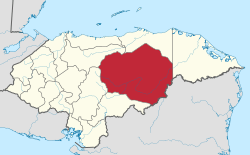Olancho Department
Olancho is the largest of all the 18 departments into which Honduras is divided. The department covers a total surface area of 24,057 km² and has an estimated 2015 population of 537,306 inhabitants.
Olancho Department Departamento de Olancho | |
|---|---|
 Location of Olancho in Honduras | |
| Coordinates: 14°36′N 86°12′W | |
| Country | |
| Municipalities | 23 |
| Villages | 287 |
| Founded | 1825[lower-alpha 1] |
| Capital city | Juticalpa |
| Government | |
| • Type | Departmental |
| • Gobernador | Walner Reginaldo Castro Rivera (2014-2022) (PNH) |
| Area | |
| • Total | 24,038 km2 (9,281 sq mi) |
| Population (2015) | |
| • Total | 537,306 |
| • Density | 22/km2 (58/sq mi) |
| Time zone | UTC-6 (CDT) |
| Postal code | 16101, 16201 |
| ISO 3166 code | HN-OL |
| HDI (2017) | 0.586[1] medium · 8th |
| Statistics derived from Consult INE online database: Population and Housing Census 2013[2] | |
The departmental capital is Juticalpa, which is also the see of the Roman Catholic Diocese of Juticalpa, which covers the department.
Terrain
Rugged mountains rise in the western and northern portions of the department, notably the Sierra de Agalta, the Montaña de Tembladeros, and the Montaña de Botaderos. Vast pine and hardwood forests cover these mountains.
Central Olancho has rolling plains, watered by the Guayape River and its affluents. These plains, sometimes called pampas due to their similarity to the vast Argentinian plains, are famous for their large cattle herds and extensive farming. The main cities, capital Juticalpa and Catacamas, are located there.
The eastern part of the department is covered with rainforests, though the influx of impoverished, farmers and intense timber extraction have increased deforestation rates in the area. A portion of the Rio Platano Biosphere Reserve, a tropical rainforest with diverse wildlife and declared a World Heritage site by UNESCO, straddles the border of Olancho and the neighboring departments of Gracias a Dios and Colón.
The Guayape River is famous for its placer gold with concessions where today the mining company Eurocantera (Goldlake Group) exploits ethical gold. First exploited by the Spaniards during the colonial period, these gold deposits are still productive. Local men and women may be seen panning for gold in riverbanks during the dry season. Extensive gold dredging is also underway during the dry season in much of the river, including deep into the mountainous regions of the Rio Patuca (into which the Guayape feeds).
History
The Cave of Talgua, also known as "The Cave of the Glowing Skulls," is located near Catacamas. It was used as a burial site by the native peoples, and over time, the bones left there were covered by the calcite dripping from the ceiling, giving them an eerie, sparkling appearance. Radiocarbon testing indicated that the burials were made around 900 B.C., well before the rise of the Mayans and other civilizations. The ossuary chamber was discovered in 1994 by a Peace Corps volunteer named Timothy Berg, along with two Catacamas locals named Desiderio Reyes and Jorge Yáñez, and research is still being conducted in the area.
In the 18th and 19th century, Olancho resisted government authority from Tegucigalpa, resulting in armed conflicts. To this day, the old independent sentiments persist among Olanchanos, although the department's role as an agricultural producer has made it an integral part of the Honduran economy. The former president of Honduras, Porfirio Lobo, hails from the department, specifically from the city of Juticalpa. Also former president now congressman Manuel Zelaya Rosales is from the city of Catacamas, also from the department
There is an accurate saying about Olancho known by all residents of the region that has become the unofficial motto: "Olancho es ancho para entrar, y angosto para salir." This is variously translated as "Olancho is easy to enter, and hard to leave", or more literally: "Olancho is wide to enter, and narrow to leave". True understanding of, and appreciation for, this motto takes years to develop. It has also been said to be because of the historical violence of the department. There is another saying, "Olancho: Entre si quiere, salga si puede" (literally, "Olancho: Enter if you want, exit if you can").
Recent violence
The Olancho Department remains one of the most violent areas in Honduras.[3] In June 2012, after a Drug Enforcement Administration agent killed a suspect in Honduras, it was confirmed that the US government has been running covert operations in the Olancho area to combat drug trafficking.[4] Currently, many multinational corporations as well as charitable and religious organizations with personnel in Honduras actively discourage their members from visiting Olancho, as do the governments of the US,[5] Canada,[6] France,[7] New Zealand[8] and the UK,[9] among others.
Municipalities

Notes
- Olancho was one of the first 7 departments in which the national territory was divided in the first political division of Honduras in 1825.
References
- "Sub-national HDI - Area Database - Global Data Lab". hdi.globaldatalab.org. Retrieved 2018-09-13.
- "Consulta Base de datos INE en línea: Censo de Población y Vivienda 2013" [Consult INE online database: Population and Housing Census 2013]. Instituto Nacional de Estadística (INE) (in Spanish). El Instituto Nacional de Estadística (INE). 1 August 2018. Retrieved 2018-09-13.
- "Honduras: Security Briefing". Honduras-information.hotelhonduras.com. Retrieved 4 October 2017.
- Savage, Charlie (24 June 2012). "D.E.A. Agents Kills Suspected Smuggler in Honduran Drug Raid". Nytimes.com. Retrieved 4 October 2017.
- "Archived copy". Archived from the original on 2013-11-05. Retrieved 2017-06-24.CS1 maint: archived copy as title (link)
- Canada, Government of Canada, Global Affairs. "Travel Advice and Advisories for Honduras". Travel.gc.ca. Retrieved 4 October 2017.
- "Honduras- Sécurité". France Diplomatie : : Ministère de l'Europe et des Affaires étrangères. Retrieved 4 October 2017.
- "Honduras : Official advice : High degree of caution". Smartraveller.gov.au. Retrieved 4 October 2017.
- "Honduras travel advice - GOV.UK". Fco.gov.uk. Retrieved 4 October 2017.